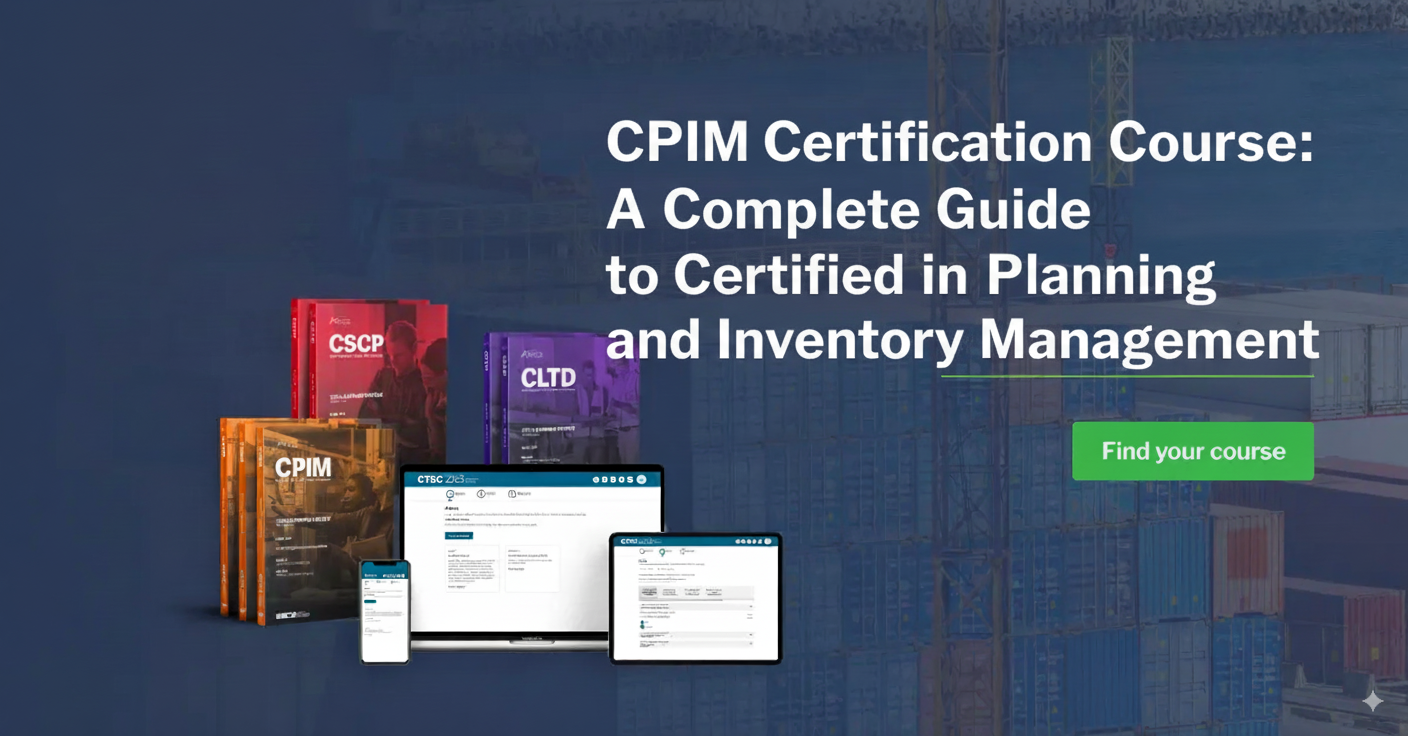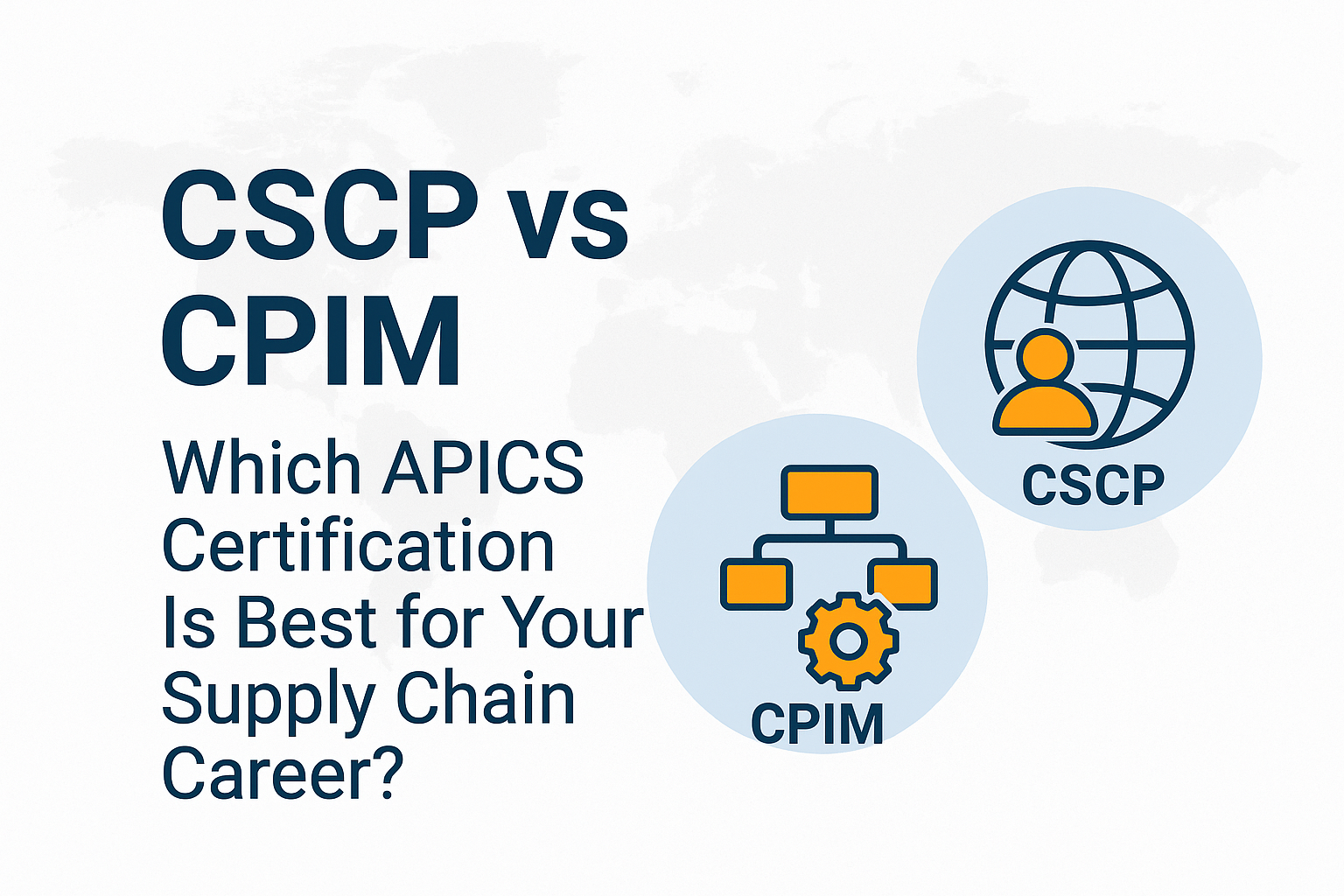Table of Contents
ToggleCPIM Certification Course Intro
In today’s volatile global economy, supply chains face unprecedented pressures: fluctuating demand, disrupted logistics, geopolitical tensions, and the rapid rise of digital technologies. Against this backdrop, businesses require professionals with a strong foundation in planning, scheduling, and inventory management to keep operations efficient and resilient.
One of the most respected credentials in this area is the CPIM Certification Course—Certified in Planning and Inventory Management—administered by the Association for Supply Chain Management (ASCM), formerly known as APICS. For more than 40 years, CPIM has been the gold standard for supply chain planners, production schedulers, and inventory specialists across industries.
This article explores the history, structure, benefits, preparation, and global impact of CPIM certification, as well as its place in the future of supply chain careers.
1. Background of APICS and ASCM
APICS Origins: Founded in 1957 as the American Production and Inventory Control Society, APICS initially served manufacturing managers seeking structured methods to plan production and control inventories.
Growth into Supply Chain Management: By the 1980s, APICS was a leader in advancing Material Requirements Planning (MRP) and Manufacturing Resource Planning (MRP II), precursors to modern ERP systems.
Transformation into ASCM: In 2018, APICS became part of the newly formed Association for Supply Chain Management (ASCM). ASCM retained the APICS brand for its certifications while expanding to cover sustainability, digital transformation, and global partnerships.
Certification Portfolio: ASCM now administers three core credentials:
CPIM Certification Course (Certified in Planning and Inventory Management)
CSCP (Certified Supply Chain Professional)
CLTD (Certified in Logistics, Transportation, and Distribution)
APICS/ASCM certifications are recognized worldwide and often required for senior supply chain roles.
2. What is CPIM Certification Course ?
Certified in Planning and Inventory Management (CPIM) is the ASCM credential that focuses specifically on the processes required to balance demand, supply, and capacity.
Focus Areas: demand forecasting, material requirements planning, master scheduling, capacity planning, inventory optimization, supplier planning, and performance measurement.
Audience: CPIM is targeted at professionals who directly plan, schedule, and manage inventory—making it more tactical and operational than CSCP, which is more strategic and global.
Legacy: Since its launch in 1973, more than 100,000 professionals worldwide have earned the CPIM designation.
3. Structure of the CPIM Certification Course
In 2021, ASCM streamlined the certification into CPIM 7.0, replacing the older 5-module structure.
Two Exams:
CPIM Part 1: Introduces fundamental supply chain and operations concepts.
CPIM Part 2: Deep dive into advanced planning and inventory topics.
Exam Format:
Computer-based testing.
150 questions (100 operational, 50 pre-test).
3.5 hours per exam.
Passing score: 300 (scaled).
Exam Availability: Offered year-round at Pearson VUE centers worldwide and online proctored.
This structure allows professionals to complete CPIM certification in 12–18 months depending on study pace.
4. Knowledge Domains Covered
The CPIM program is comprehensive, covering the end-to-end planning cycle within operations and supply chains:
Supply Chain Fundamentals – Key concepts, terminology, frameworks.
Demand Management – Forecasting methods, demand planning, customer relationship management.
Master Planning – Sales and operations planning (S&OP), master production scheduling (MPS).
Detailed Scheduling and Planning – Material requirements planning (MRP), capacity requirements planning (CRP), supplier management.
Inventory Management – ABC analysis, EOQ, safety stock, lot sizing, replenishment methods.
Execution and Control of Operations – Production activity control, shop floor scheduling, lean/JIT principles.
Sustainability and Continuous Improvement – Risk management, circular supply chains, environmental impact.
This body of knowledge blends technical detail with business acumen, making CPIM unique compared to other credentials.
5. Benefits of CPIM Certification
For Professionals
Career Advancement: CPIM-holders often progress to roles such as supply chain manager, planning director, or operations VP.
Salary Premium: ASCM salary surveys consistently show certified professionals earn 15–20% higher salaries than non-certified peers.
Skill Recognition: Demonstrates mastery of global standards in planning and inventory control.
For Companies
Improved Accuracy: Better demand forecasting and inventory control reduces costs and stockouts.
Standardization: Provides a common language for supply chain professionals.
Resilience: Helps companies respond faster to disruptions.
6. Who Should Pursue CPIM?
Early-career professionals: analysts, planners, schedulers.
Mid-career managers: supply chain supervisors, purchasing managers, inventory controllers.
Industry scope: CPIM is used in manufacturing, retail, healthcare, aerospace, food & beverage, and logistics.
Anyone involved in demand planning, supply planning, production scheduling, or inventory optimization benefits from CPIM.
7. Preparation Options
Candidates can choose from multiple study methods:
APICS Learning System: Comprehensive self-study modules with quizzes and case studies.
Instructor-led courses: Delivered by ASCM chapters and partners worldwide.
Online programs: Virtual live training and blended learning.
Independent study: Using textbooks and practice exams.
Recommended preparation time is 100–150 hours per exam.
8. CPIM vs. Other Certifications
CPIM vs. CLTD:
CPIM vs. PMP/Six Sigma:
PMP = project management.
Six Sigma = quality improvement.
CPIM = supply chain planning.
Each has distinct purposes; many professionals pursue multiple.
9. Global Recognition and Adoption
Worldwide footprint: CPIM-certified professionals are present in 100+ countries.
Adoption in enterprises: Multinationals like IBM, Procter & Gamble, and Johnson & Johnson encourage or require CPIM for certain roles.
Academic partnerships: Universities integrate CPIM prep into supply chain degree programs.
CPIM’s credibility stems from decades of continuous relevance in a rapidly evolving field.
10. Emerging Trends and CPIM
Digital Supply Chains: CPIM now integrates concepts like ERP, APS, and AI-based planning.
Sustainability: Reflects growing importance of circular supply chains and carbon accountability.
Resilience: Emphasis on risk management after COVID-19 disruptions.
Industry 4.0: CPIM provides a foundation for integrating automation and IoT into planning systems.
11. Costs and Investment
Exam Fees (2025 rates, approximate):
ASCM members: $495 per exam.
Non-members: $690 per exam.
Learning System: $995 (member price).
Total investment: $1,500–$2,500 depending on membership and study method.
While significant, the ROI is high given the career benefits.
12. Renewal and Maintenance
CPIM certification is valid for five years.
Requires 75 professional development points (education, teaching, service) for renewal.
Ensures skills remain updated with industry developments.
13. Case Studies and Impact
Individual: A demand planner in a manufacturing company leveraged CPIM training to reduce excess inventory by 20%, freeing working capital.
Corporate: A healthcare firm reported improved service levels and lower stockouts after sponsoring its planners through CPIM.
Education: Universities report CPIM graduates have higher placement rates and better salaries.
Conclusion:
The CPIM certification remains one of the most powerful credentials for supply chain professionals worldwide. By focusing on planning, scheduling, and inventory management, it equips individuals with the skills to navigate uncertainty, optimize resources, and deliver measurable results.
For professionals, it is a career accelerant. For organizations, it is a proven way to build resilient supply chains. And in a world of increasing disruption, CPIM offers the clarity, structure, and credibility needed to transform supply chain challenges into opportunities.
Is your business built on these foundational facts, or are you operating on outdated playbooks? At Trax Group, We help businesses like yours leverage these fundamental business growth facts to build a powerful strategy, and execute for sustainable growth.
F.A.Qs
Frequently asked questions
Certified in Planning and Inventory Management.
The Association for Supply Chain Management (ASCM), formerly APICS.
Two: Part 1 and Part 2.
Typically 12–18 months
$1,500–$2,500 including exams and learning system.
Pearson VUE centers or online with remote proctoring.
Planners, schedulers, buyers, inventory managers, supply chain analysts.
Yes, it is recognized in over 100 countries.
Five years, renewable with professional development.
Certified professionals earn ~15–20% more.
Other Questions
General questions
CPIM = operational planning. CSCP = global strategic view.
Yes, many universities integrate CPIM prep courses.
Manufacturing, logistics, retail, healthcare, aerospace.
No, but practical experience helps.
Through 75 development points every 5 years.
Yes, ASCM offers online learning systems.
Yes, sustainability and risk management are now included.
They differ—PMP focuses on project management, CPIM on supply chain planning.
Yes, since it covers MRP and master scheduling.
Yes, as planning remains critical even in digital supply chains.








No comment